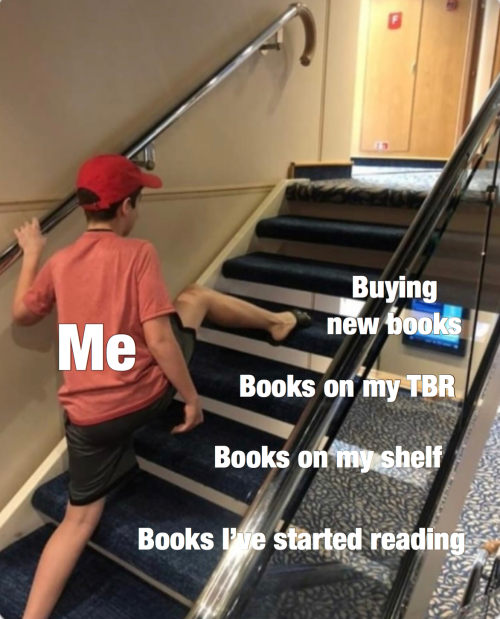
18 | random literature stuff | dormant acc, mostly used for interactions only | more active on @sunbeamrocks
59 posts
Trivia Tuesday #2
Trivia Tuesday #2
After finishing a book, I kiss its front page and sob quietly. I hold it tight and cradle it like a baby. It's my farewell ritual. Afterwards, I don't know if I can find another book that can satisfy the last one I've just read.
-
 danasdreams liked this · 4 years ago
danasdreams liked this · 4 years ago -
 marxsound liked this · 5 years ago
marxsound liked this · 5 years ago
More Posts from Bibliobuddy
Reading opens our minds to the world around us, taking us to places even though we're only within four walls.
One real benefit of reading I rarely hear anybody mention is how much more interesting life becomes when you read a lot. It depends what you’re reading, of course, but most (good) books will teach you something you didn’t already know, and even if you have to give the book back to the library, you get to take that much with you. A lot of people talk about things they wish they’d studied in school–I’ve done it, too–but it’s a nice consolation prize that you can always pick up a book and learn something new. And as that library in your brain collects more volumes, everything around you gains new resonances, new context, and new connections which make your lived experience richer. In quarantine alone I’ve read about religion and politics and history and evolution and computer science and astrophysics without even leaving my house and it’s already a more interesting world.
We need more diverse books in literature. More voices need to be represented.



The Cooperative Children’s Book Center has released the results of their 2019 survey on diversity in kidlit/YA.
We thank them for this invaluable work, note their commitment to adding Arabs/Arab Americans in future surveys, and present these graphs of their findings.
The 3,716 books surveyed have this many main characters total for the following groups:
Black/African: 11.9%
First/Native Nations: 1%
Asian/Asian American: 8.7%
Latinx: 5.3%
Pacific Islander: 0.05%
White: 41.8%
Animal/Other: 29.2%
LGBTQIAP+: 3.1%
Disability: 3.4%
“Taken together, books about white children, talking bears, trucks, monsters, potatoes, etc. represent nearly three quarters (71%) of children’s and young adult books published in 2019.” - librarian Madeline Tyner
When we looked at the breakdown for IPOC creatives who wrote and/or illustrated stories with characters of their own race, we found the following:
First/Native Nations: 68.2%
Pacific Islander: 80%
Latinx: 95.7%
Asian/Asian American: 100%*
*NOTE: these percentages include both authors and illustrators and, as pointed out by author Linda Sue Park for past surveys, Asians/Asian Americans are frequently illustrators but not necessarily authors of their own stories, meaning this is not fully reflective of #OwnVoices representation.
Black/African creatives wrote and/or illustrated only 46.4% of stories featuring Black/African characters.
This is the work that still needs to be done.
5 Great Articles About Reading
...to help you adapt the habit in our fast-changing world.
Your mom tells you to read. Your teacher or your boss tells you to read. Successful individuals tell you to read. They're right to tell you so.
For non-readers, it's not going to be an easy task. Reading is tedious. Sometimes a bit irksome, too. You find that words are drowning you in boredom and irritation before turning to the next page.
This is why I've collected a list of five helpful articles to aid you in reading actively, effectively, and habitually. Whether you're an avid bookworm like me or a stranger to pages, these articles can help you acquire the habit in our modern-day society.
1. How to Read the Right Way: A Complete Guide | Medium
Even books and reading evolve. In this article, author Melissa Chu tackles the art of speed reading, the pros and cons of different reading formats, and how to read in a changing society.
2. The Complete Guide to Effective Reading | Medium
Worry about memorizing dates for your history exam? Maarten van Doorn takes you into an in-depth analysis of acquiring information into your long-term memory, as well as how to read actively.
3. 14 Ways to Cultivate a Lifetime Reading Habit | Life Hack
Reading is a habit, not a chore. If it isn't one of your pastimes yet, don't worry! Life Hack presents to you 14 ways to make reading a pleasurable and worthwhile habit.
4. The Case for Reading Fiction | Harvard Business Review
Business and companies look for various skills and good characteristics in their employees. Harvard Business Review says that reading literary fiction can help you develop these in-demand traits, and ultimately become a better person.
5. Books are good for your brain. These techniques will help you read more | Popular Science
Here's the science behind the effects and benefits of reading. Popular Science shows you not only how to make reading a habit, but also how to read more and achieve your reading goal.
These are just some of the multitudes of articles I've found to help you learn to read. I hope this helps spark your inner reader!
It happens way too often.

Trivia Tuesday #3
Bookworm vocabulary: Abibliophobia is the fear of running out of reading material. Bibliosmia is the love of the smell of old books. Tsundoku (Japanese) means to let reading materials pile up in one's home and never read them.